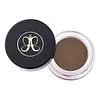What's inside
What's inside
 Key Ingredients
Key Ingredients

 Benefits
Benefits

 Concerns
Concerns

 Ingredients Side-by-side
Ingredients Side-by-side

Ethylhexyl Palmitate
EmollientRicinus Communis Seed Oil
MaskingTridecyl Trimellitate
EmollientSilica
AbrasiveMica
Cosmetic ColorantBis-Diglyceryl Polyacyladipate-2
EmollientCopernicia Cerifera Wax
Synthetic Wax
AbrasiveSilica Dimethyl Silylate
EmollientCeresin
Emulsion StabilisingMicrocrystalline Wax
Emulsion StabilisingQuaternium-18 Bentonite
Phenoxyethanol
PreservativePolyisobutene
Caprylyl Glycol
EmollientQuartz
AbrasiveCI 77891
Cosmetic ColorantIron Oxides
Triethoxycaprylylsilane
Boron Nitride
AbsorbentOctyldodecyl Stearoyl Stearate
EmollientMagnesium Palmitate
Magnesium Stearate
Cosmetic ColorantMethicone
EmollientDimethicone
EmollientAlumina
AbrasiveEthylhexyl Palmitate, Ricinus Communis Seed Oil, Tridecyl Trimellitate, Silica, Mica, Bis-Diglyceryl Polyacyladipate-2, Copernicia Cerifera Wax, Synthetic Wax, Silica Dimethyl Silylate, Ceresin, Microcrystalline Wax, Quaternium-18 Bentonite, Phenoxyethanol, Polyisobutene, Caprylyl Glycol, Quartz, CI 77891, Iron Oxides, Triethoxycaprylylsilane, Boron Nitride, Octyldodecyl Stearoyl Stearate, Magnesium Palmitate, Magnesium Stearate, Methicone, Dimethicone, Alumina
Cyclopentasiloxane
EmollientIsododecane
EmollientSilica
AbrasivePolyethylene
AbrasiveTrimethylsiloxysilicate
EmollientSynthetic Wax
AbrasiveCyclohexasiloxane
EmollientBis-Diglyceryl Polyacyladipate-2
EmollientSilica Dimethyl Silylate
EmollientCaprylyl Glycol
EmollientEthylhexylglycerin
Skin ConditioningPropylparaben
PreservativeTocopheryl Acetate
AntioxidantMica
Cosmetic ColorantCI 77163
Cosmetic ColorantIron Oxides
CI 77891
Cosmetic Colorant
 Reviews
Reviews

Ingredients Explained
These ingredients are found in both products.
Ingredients higher up in an ingredient list are typically present in a larger amount.
This ingredient is lipid-based synthetic skin-conditioning agent derived from adipic acid and a mixture of fatty acids. It is often called a lanolin substitute.
As an emollient, it helps soften and hydrate the skin. Emollients create a barrier on the skin to trap moisture in.
Due to its fatty acid base, it may not be Malassezia folliculitis safe.
Learn more about Bis-Diglyceryl Polyacyladipate-2Caprylyl Glycol is a humectant and emollient, meaning it attracts and preserves moisture.
It is a common ingredient in many products, especially those designed to hydrate skin. The primary benefits are retaining moisture, skin softening, and promoting a healthy skin barrier.
Though Caprylyl Glycol is an alcohol derived from fatty acids, it is not the kind that can dry out skin.
This ingredient is also used as a preservative to extend the life of products. It has slight antimicrobial properties.
Learn more about Caprylyl GlycolCi 77891 is a white pigment from Titanium dioxide. It is naturally found in minerals such as rutile and ilmenite.
It's main function is to add a white color to cosmetics. It can also be mixed with other colors to create different shades.
Ci 77891 is commonly found in sunscreens due to its ability to block UV rays.
Learn more about CI 77891Mica is a naturally occurring mineral used to add shimmer and color in cosmetics. It can also help improve the texture of a product or give it an opaque, white/silver color.
Serecite is the name for very fine but ragged grains of mica.
This ingredient is often coated with metal oxides like titanium dioxide. Trace amounts of heavy metals may be found in mica, but these metals are not harmful in our personal products.
Mica has been used since prehistoric times throughout the world. Ancient Egyptian, Indian, Greek, Roman, Aztec, and Chinese civilizations have used mica.
Learn more about MicaSilica, also known as silicon dioxide, is a naturally occurring mineral. It is used as a fine, spherical, and porous powder in cosmetics.
Though it has exfoliant properties, the function of silica varies depending on the product.
The unique structure of silica enhances the spreadability and adds smoothness, making it a great texture enhancer.
It is also used as an active carrier, emulsifier, and mattifier due to its ability to absorb excess oil.
In some products, tiny microneedles called spicules are made from silica or hydrolyzed sponge. When you rub them in, they lightly polish away dead skin layers and enhance the penetration of active ingredients.
Learn more about SilicaThis silica is mainly used to thicken oils and suspend particles in oils. It is not water soluble.
According to the manufacturer, it:
The manufacturer also claims this ingredient to be useful in makeup.
In lipstick formulations, this ingredient improves color payoff, reduces pigment settling, and reduces oil bleeding. This ingredient also improves the grip of powder products such as dry shampoos.
Learn more about Silica Dimethyl SilylateSynthetic Wax is created from fossil fuels such as natural gas. It is used to enhance texture, adjust pH, and as an occlusive.
It may also be used as an abrasive ingredient to exfoliate the skin.
Synthetic Wax may not be fungal acne safe.
Learn more about Synthetic WaxThis ingredient is a combination of red, black, and yellow iron oxide pigments. This combination of colors is usually found in foundation, because it results in a "skin" color.